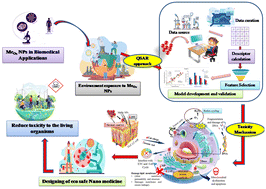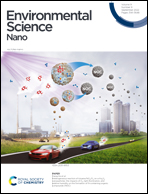Risk assessment and data gap filling of toxicity of metal oxide nanoparticles (MeOx NPs) used in nanomedicines: a mechanistic QSAR approach†
Abstract
Nanotechnology has become a fast-growing area of science. Recently, there has been an increase in the use of metal oxide nanoparticles (MeOx NPs) due to their unique morphology and physical properties. The application of MeOx NPs in nanomedicines has opened up new perspectives for medical devices and development in health care. Nanomedicines and nanotoxicity are complementary to each other. Lack of sufficient data and low-adequacy experimental setups obstruct the assessment of their potential risk to human cells. Regulatory authorities have also encouraged the application of the quantitative structure–activity relationship (QSAR) approach towards the safe design of nano-based products. Therefore, in the present computational study, multiple linear regression (MLR) modeling with 16 MeOx NP datasets and partial least squares (PLS) regression modeling with 15 MeOx NP datasets (117 data points with different physical features and conditions) were performed to determine the cytotoxicity of NPs towards HaCaT cells. Easily interpretable periodic table descriptors (1st and 2nd generation) and some previously reported physical descriptors were employed for modeling. The genetic algorithm (GA) followed by best subset selection (BSS) technique was applied before the model development. The final MLR model (4 descriptors) and PLS (2 LVs) model for the two datasets was rigorously validated with various stringent validation criteria following the strict Organisation for Economic Co-operation and Development (OECD) guidelines. The statistical data of the MLR model (Q(LOO)2 = 0.83, R2 = 0.95) and PLS model (Q(LOO)2 = 0.73, R2 = 0.76) were robust and reliable. Features like electronegativity, formation of a metal cation, increase in solubility, and dose were important for the mechanism of toxicity. Therefore, these models can be efficient tools for designing modern materials with optimal properties and minimal potential toxicity.



 Please wait while we load your content...
Please wait while we load your content...